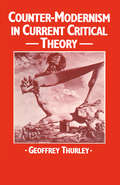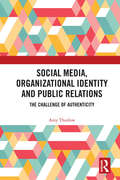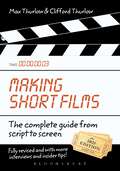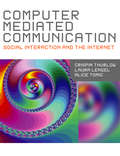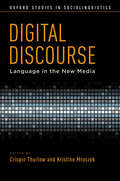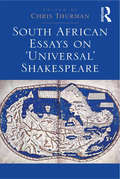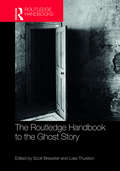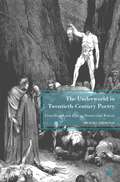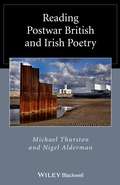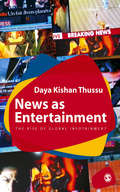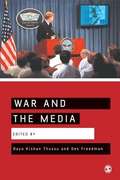- Table View
- List View
Social Media, Organizational Identity and Public Relations: The Challenge of Authenticity (Routledge New Directions in PR & Communication Research)
by Amy ThurlowPublic relations has been swift to grasp social media, yet its impact on public relations practice remains relatively unexplored. This book focusses on a way of understanding organizational identity construction in a virtual context, developing scholarship on the importance of a virtual presence in PR management, and further, to make sense of these identities as authentic, legitimate or plausible. Through a diverse group of empirical case studies, this book explores the global perspective on organizational identities which transcend global boundaries via the internet including Volkswagen’s emissions scandal and Monsanto and organized social media protests. It also explores crowdfunding – an emerging form of capitalist development constructed through sensemaking in social media. By looking at the emergence of organization in today’s social media environment, it identifies how the interactive is created on a digitally mediated platform, sharing knowledge and engaging individuals in organizational identity construction. Viewing the social construction of organizational identities through this lens, this innovative book locates how identities are plausible, authentic and legitimate - or not – through their ongoing communication via social media. It will be of great interest to academics teaching and researching in public relations, organisational communication and social media.
Social Media, Organizational Identity and Public Relations: The Challenge of Authenticity (Routledge New Directions in PR & Communication Research)
by Amy ThurlowPublic relations has been swift to grasp social media, yet its impact on public relations practice remains relatively unexplored. This book focusses on a way of understanding organizational identity construction in a virtual context, developing scholarship on the importance of a virtual presence in PR management, and further, to make sense of these identities as authentic, legitimate or plausible. Through a diverse group of empirical case studies, this book explores the global perspective on organizational identities which transcend global boundaries via the internet including Volkswagen’s emissions scandal and Monsanto and organized social media protests. It also explores crowdfunding – an emerging form of capitalist development constructed through sensemaking in social media. By looking at the emergence of organization in today’s social media environment, it identifies how the interactive is created on a digitally mediated platform, sharing knowledge and engaging individuals in organizational identity construction. Viewing the social construction of organizational identities through this lens, this innovative book locates how identities are plausible, authentic and legitimate - or not – through their ongoing communication via social media. It will be of great interest to academics teaching and researching in public relations, organisational communication and social media.
Making Short Films, Third Edition: The Complete Guide from Script to Screen
by Clifford Thurlow Max ThurlowMaking movies is the most exciting way to earn a living and it is not surprising that media and film studies remain the most popular courses at colleges across the western world. A short film provides an opportunity for elliptical, poetic, condensed story telling. Shorts can take risks rarely seen in features. It is the arena where a strong voice or individual vision is possible; an invitation for experimentation and originality. Making Short Films, 3rd edition is entirely revised and restructured, providing a much more complete and detailed guide to filmmaking, with more information on new technology, illustrations and ideas for best practice.
Making Short Films, Third Edition: The Complete Guide from Script to Screen
by Clifford Thurlow Max ThurlowMaking movies is the most exciting way to earn a living and it is not surprising that media and film studies remain the most popular courses at colleges across the western world. A short film provides an opportunity for elliptical, poetic, condensed story telling. Shorts can take risks rarely seen in features. It is the arena where a strong voice or individual vision is possible; an invitation for experimentation and originality. Making Short Films, 3rd edition is entirely revised and restructured, providing a much more complete and detailed guide to filmmaking, with more information on new technology, illustrations and ideas for best practice.
The Business of Words: Wordsmiths, Linguists, and Other Language Workers
by Crispin ThurlowThe Business of Words examines the practices of ‘high-end’ language workers or wordsmiths where we find words being professionally designed, institutionally managed, and, inevitably, objectified for status and profit. Aligned with existing work on language and political economy in critical sociolinguistics and discourse studies, the volume offers a novel, complementary insight into the relatively elite practices of language workers such as advertisers, dialect coaches, publishers, judges, translators, public relations officers, fine artists, journalists, and linguists themselves. In fact, the book considers what academics might learn about language from other wordsmiths, opening a space for ‘dialogue’ between those researching language and those who also stake a claim to linguistic expertise and a way with words. Bringing together an array of leading international scholars from the cognate fields of discourse studies, sociolinguistics, and linguistic anthropology, this book is an essential resource for researchers, advanced undergraduate, and postgraduate students of English language, linguistics and applied linguistics, communication and media studies, and anthropology.
The Business of Words: Wordsmiths, Linguists, and Other Language Workers
by Crispin ThurlowThe Business of Words examines the practices of ‘high-end’ language workers or wordsmiths where we find words being professionally designed, institutionally managed, and, inevitably, objectified for status and profit. Aligned with existing work on language and political economy in critical sociolinguistics and discourse studies, the volume offers a novel, complementary insight into the relatively elite practices of language workers such as advertisers, dialect coaches, publishers, judges, translators, public relations officers, fine artists, journalists, and linguists themselves. In fact, the book considers what academics might learn about language from other wordsmiths, opening a space for ‘dialogue’ between those researching language and those who also stake a claim to linguistic expertise and a way with words. Bringing together an array of leading international scholars from the cognate fields of discourse studies, sociolinguistics, and linguistic anthropology, this book is an essential resource for researchers, advanced undergraduate, and postgraduate students of English language, linguistics and applied linguistics, communication and media studies, and anthropology.
Elite Discourse: The rhetorics of status, privilege and power
by Crispin Thurlow Adam JaworskiElite Discourse examines how language and communication – or just discourse – define, mediate and legitimize class privilege. It does so from the perspective of those people and places who often stand to gain most from inequality. Collectively, chapters consider language and communication that is elitist in its appeal to distinction, excellence and superiority; they also describe the ways in which various groups and institutions lay claim to ‘eliteness’ as a way to position themselves (or to be positioned by others) as elite or non-elite. As such, chapters are concerned as much with discourse about elite status as they are with the discourse of elites – those groups commonly defined by their material wealth, political control, or demographic rarity. Ultimately, Elite Discourse views ‘elite’ as something we do, rather than something we necessarily have or are. Indeed, elite status and eliteness point us to the rhetorical strategies by which many people differentiate themselves and by which they access symbolic-material resources for shoring up their status, privilege and power. This book was originally published as a special issue of Social Semiotics.
Computer Mediated Communication
by Crispin Thurlow Dr Lara M. Lengel Professsor Alice TomicThis book offers students a task-based introduction to Computer-Mediated Communication and the impact of the internet on social interaction. Divided into four parts which require students to learn, (theory), critique, (current issues), explore, (methods), and reflect, (practice), the book aims to: Provide a foundation to the social and communicative nature of information and communication technologies Enable students to engage with the key theoretical issues associated with CMC Equip students with the necessary research and technical skills as a stimulus to independent enquiry. In spite of the rapidly increasing interest in Internet Studies and CMC and the introduction of many university courses in the area, no specialised, introductory textbook exists. This coursebook responds to the need for such a text. Aimed primarily at communication students, this book would also be useful as a sourcebook for students of media, sociology, psychology and English Language Studies. Companion website resources can be found at http://crispinthurlow.net/cmc/
Computer Mediated Communication (PDF)
by Crispin Thurlow Dr Lara M. Lengel Professsor Alice TomicThis book offers students a task-based introduction to Computer-Mediated Communication and the impact of the internet on social interaction. Divided into four parts which require students to learn, (theory), critique, (current issues), explore, (methods), and reflect, (practice), the book aims to: Provide a foundation to the social and communicative nature of information and communication technologies Enable students to engage with the key theoretical issues associated with CMC Equip students with the necessary research and technical skills as a stimulus to independent enquiry. In spite of the rapidly increasing interest in Internet Studies and CMC and the introduction of many university courses in the area, no specialised, introductory textbook exists. This coursebook responds to the need for such a text. Aimed primarily at communication students, this book would also be useful as a sourcebook for students of media, sociology, psychology and English Language Studies. Companion website resources can be found at http://crispinthurlow. net/cmc/
Digital Discourse: Language in the New Media (Oxford Studies in Sociolinguistics #21)
by Crispin Thurlow Kristine MroczekDigital Discourse offers a distinctly sociolinguistic perspective on the nature of language in digital technologies. It starts by simply bringing new media sociolinguistics up to date, addressing current technologies like instant messaging, textmessaging, blogging, photo-sharing, mobile phones, gaming, social network sites, and video sharing. Chapters cover a range of communicative contexts (journalism, gaming, tourism, leisure, performance, public debate), communicators (professional and lay, young people and adults, intimates and groups), and languages (Irish, Hebrew, Chinese, Finnish, Japanese, German, Greek, Arabic, and French). The volume is organized around topics of primary interest to sociolinguists, including genre, style and stance. With commentaries from the two most internationally recognized scholars of new media discourse (Naomi Baron and Susan Herring) and essays by well-established scholars and new voices in sociolinguistics, the volume will be more current, more diverse, and more thematically unified than any other collection on the topic.
Digital Discourse: Language in the New Media (Oxford Studies in Sociolinguistics)
by Crispin Thurlow Kristine MroczekDigital Discourse offers a distinctly sociolinguistic perspective on the nature of language in digital technologies. It starts by simply bringing new media sociolinguistics up to date, addressing current technologies like instant messaging, textmessaging, blogging, photo-sharing, mobile phones, gaming, social network sites, and video sharing. Chapters cover a range of communicative contexts (journalism, gaming, tourism, leisure, performance, public debate), communicators (professional and lay, young people and adults, intimates and groups), and languages (Irish, Hebrew, Chinese, Finnish, Japanese, German, Greek, Arabic, and French). The volume is organized around topics of primary interest to sociolinguists, including genre, style and stance. With commentaries from the two most internationally recognized scholars of new media discourse (Naomi Baron and Susan Herring) and essays by well-established scholars and new voices in sociolinguistics, the volume will be more current, more diverse, and more thematically unified than any other collection on the topic.
South African Essays on 'Universal' Shakespeare
by Chris ThurmanSouth African Essays on ’Universal’ Shakespeare collects new scholarship and extant (but previously unpublished) material, reflecting the changing nature of Shakespeare studies across various ’generation gaps’. Each essay, in exploring the nuances of Shakespearean production and reception across time and space, is inflected by a South African connection. In some cases, this is simply because of the author’s nationality or institutional affiliation; in others, there is a direct engagement with what Shakespeare means, or has meant, in South Africa. By investigating the universality of Shakespeare from both implicitly and explicitly ’southern’ perspectives, the book presents new possibilities for considering (and reassessing) shifting manifestations of Shakespeare’s work in major Shakespearean ’centres’ such as Britain and the United States, as well as across the global North and South.
South African Essays on 'Universal' Shakespeare
by Chris ThurmanSouth African Essays on ’Universal’ Shakespeare collects new scholarship and extant (but previously unpublished) material, reflecting the changing nature of Shakespeare studies across various ’generation gaps’. Each essay, in exploring the nuances of Shakespearean production and reception across time and space, is inflected by a South African connection. In some cases, this is simply because of the author’s nationality or institutional affiliation; in others, there is a direct engagement with what Shakespeare means, or has meant, in South Africa. By investigating the universality of Shakespeare from both implicitly and explicitly ’southern’ perspectives, the book presents new possibilities for considering (and reassessing) shifting manifestations of Shakespeare’s work in major Shakespearean ’centres’ such as Britain and the United States, as well as across the global North and South.
Understanding Sublimation in Freudian Theory and Modernist Writing (Routledge Studies in Twentieth-Century Literature)
by Luke ThurstonWhat is at stake in Freud’s enduring preoccupation with a process supposedly diverting sexuality into cultural activity? In this study, a leading scholar of psychoanalysis and literature re-opens the old question of sublimation in a critical reading that explores one of the last remaining puzzles of Freudian thought. Using the rigorous framework provided by Jean Laplanche, Luke Thurston resituates sublimation as an unfinished Freudian concept bound up with a much wider history of philosophical and literary reflection. Exploring the misunderstanding and reinvention of sublimation both in accounts of cultural history and in Lacan’s celebrated reading of Antigone, Thurston challenges some of the prevalent assumptions still seen in contemporary “theory.” Thurston links his critical investigation of psychoanalysis to modernist literature, discovering both parallels and alternatives to Freud’s idea of sublimation in little-known works by May Sinclair and David Jones. The study concludes by arguing that these modernist artists, both of whom were significantly affected by trauma during the First World War, produced work radically at odds with the established canons of representation, and that this “anti-hermeneutic” art can be linked to a “Copernican” sublimation, a process not controlled by the ego but vitalizing it and decentring its habitual structure.
Understanding Sublimation in Freudian Theory and Modernist Writing (Routledge Studies in Twentieth-Century Literature)
by Luke ThurstonWhat is at stake in Freud’s enduring preoccupation with a process supposedly diverting sexuality into cultural activity? In this study, a leading scholar of psychoanalysis and literature re-opens the old question of sublimation in a critical reading that explores one of the last remaining puzzles of Freudian thought. Using the rigorous framework provided by Jean Laplanche, Luke Thurston resituates sublimation as an unfinished Freudian concept bound up with a much wider history of philosophical and literary reflection. Exploring the misunderstanding and reinvention of sublimation both in accounts of cultural history and in Lacan’s celebrated reading of Antigone, Thurston challenges some of the prevalent assumptions still seen in contemporary “theory.” Thurston links his critical investigation of psychoanalysis to modernist literature, discovering both parallels and alternatives to Freud’s idea of sublimation in little-known works by May Sinclair and David Jones. The study concludes by arguing that these modernist artists, both of whom were significantly affected by trauma during the First World War, produced work radically at odds with the established canons of representation, and that this “anti-hermeneutic” art can be linked to a “Copernican” sublimation, a process not controlled by the ego but vitalizing it and decentring its habitual structure.
The Routledge Handbook to the Ghost Story (Routledge Literature Handbooks)
by Luke Thurston Scott BrewsterThe Handbook to the Ghost Story sets out to survey and significantly extend a new field of criticism which has been taking shape over recent years, centring on the ghost story and bringing together a vast range of interpretive methods and theoretical perspectives. The main task of the volume is to properly situate the genre within historical and contemporary literary cultures across the globe, and to explore its significance within wider literary contexts as well as those of the supernatural. The Handbook offers the most significant contribution to this new critical field to date, assembling some of its leading scholars to examine the key contexts and issues required for understanding the emergence and development of the ghost story.
The Underworld in Twentieth-Century Poetry: From Pound and Eliot to Heaney and Walcott
by M. ThurstonThe hero s descent into the Underworld is not only one of the oldest stories in western literature; it is also one of the most often retold. Why do so many modern poets - British and American, black and white, male and female, from the metropole and from the margins - stage Underworld descents in their works? Through a series of contextualized close readings, this study traces the cultural work performed by modern deployments of the classical narrative. While some poets engage their literary forebears to exorcise anxiety and others use Hell to sharpen their cultural critique, most recent poets, including James Merrill, Derek Walcott, Tony Harrison, and Seamus Heaney, have found the Underworld descent to be a useful framework for addressing the claims of history and politics.
Reading Postwar British and Irish Poetry (Wiley Blackwell Reading Poetry #16)
by Michael Thurston Nigel AldermanCombining detailed explorations of both mainstream and experimental poets with a clear historical and literary overview, Reading Postwar British and Irish Poetry offers readers at all levels an ideal guide to the rich body of poetic works published in Britain and Ireland over the last half-century. Features detailed discussions of individual poems that are widely available in anthologies and selected poems volumes Pays explicit attention to how to read the poems, focusing on language and form and the institutional conditions of literary possibility in which poets worked Includes poets of all types and styles from throughout the post-war period, including canonical and mainstream poets alongside experimental poets, women, and poets of color
Reading Postwar British and Irish Poetry (Wiley Blackwell Reading Poetry #15)
by Michael Thurston Nigel AldermanCombining detailed explorations of both mainstream and experimental poets with a clear historical and literary overview, Reading Postwar British and Irish Poetry offers readers at all levels an ideal guide to the rich body of poetic works published in Britain and Ireland over the last half-century. Features detailed discussions of individual poems that are widely available in anthologies and selected poems volumes Pays explicit attention to how to read the poems, focusing on language and form and the institutional conditions of literary possibility in which poets worked Includes poets of all types and styles from throughout the post-war period, including canonical and mainstream poets alongside experimental poets, women, and poets of color
News as Entertainment: The Rise of Global Infotainment
by Daya Thussu"Thussu brings to this project the passion for news of a socially committed former journalist, the political economy of his international relations education and a formidable assembly of global detail, examining the recent explosion of 'infotainment'." - John Downing, Southern Illinois University "Thussu's account of war as infotainment, the Bollywoodization of news and the emergence of a global infotainment sphere is as compelling as it is alarming. This is a significant and essential book for anyone interested in exploring the connections between news journalism, informed citizenship and democracy." - Bob Franklin, The Cardiff School of Journalism, Media and Cultural Studies Richly detailed and empirically grounded, this first book-length study of infotainment and its globalization by a leading scholar of global communication, offers a comprehensive and critical analysis of this emerging phenomenon. Going beyond - both geographically and theoretically - the 'dumbing down' discourse, largely confined to the Anglo-American media, the book argues that infotainment may have an important ideological role, a diversion in which 'soft news' masks the hard realities of neo-liberal imperialism. Chapters include a historical appraisal of infotainment; the infrastructure for its globalization as well as coverage of recent wars on television news as high-tech infotainment and the growing synergies between Hollywood and Bollywood-originated infotainment. A 'global infotainment sphere' is emerging, the book argues, within which competing versions of news - from 24/7 news networks to bloggers - coexist. Accessible, engagingly written and robustly argued, the book combines analyses of theoretical debates on infotainment with extensive and up-to-date comparative data.
News as Entertainment: The Rise of Global Infotainment (PDF)
by Daya Thussu"Thussu brings to this project the passion for news of a socially committed former journalist, the political economy of his international relations education and a formidable assembly of global detail, examining the recent explosion of 'infotainment'." - John Downing, Southern Illinois University "Thussu's account of war as infotainment, the Bollywoodization of news and the emergence of a global infotainment sphere is as compelling as it is alarming. This is a significant and essential book for anyone interested in exploring the connections between news journalism, informed citizenship and democracy." - Bob Franklin, The Cardiff School of Journalism, Media and Cultural Studies Richly detailed and empirically grounded, this first book-length study of infotainment and its globalization by a leading scholar of global communication, offers a comprehensive and critical analysis of this emerging phenomenon. Going beyond - both geographically and theoretically - the 'dumbing down' discourse, largely confined to the Anglo-American media, the book argues that infotainment may have an important ideological role, a diversion in which 'soft news' masks the hard realities of neo-liberal imperialism. Chapters include a historical appraisal of infotainment; the infrastructure for its globalization as well as coverage of recent wars on television news as high-tech infotainment and the growing synergies between Hollywood and Bollywood-originated infotainment. A 'global infotainment sphere' is emerging, the book argues, within which competing versions of news - from 24/7 news networks to bloggers - coexist. Accessible, engagingly written and robustly argued, the book combines analyses of theoretical debates on infotainment with extensive and up-to-date comparative data.
War and the Media: Reporting Conflict 24/7
by Daya Thussu Des Freedman`No book is more timely than this collection, which analyses brilliantly the Western media's relentless absorption into the designs of dominant, rapacious power' - John Pilger `A most timely book, with many valuable insights' - Martin Bell O.B.E `It has long been known that the outcome of war is deeply influenced by the battle to win 'hearts and minds'. This book provides a stimulating set of perspectives which combine the analyses of prominent academics with the experiences of leading journalists' - Professor Tom Woodhouse, University of Bradford `This volume represents an all-star cast of authors who have a tremendous amount of knowledge about media and world conflict. One of its strengths is that it doesn't focus entirely narrowly on media, but puts the discussion of media issues in the context of changes in the world order in military doctrine' - Professor Daniel C. Hallin, University of California `This book comes just in time. A coherent and wide-ranging collection of data, analyses and insights that help our understanding of the complex interaction between communication and conflict. A major intellectual contribution to critical thinking about the early 21st century' - Cees J Hamelink, Professor International Communication, University of Amsterdam With what new tools do governments manage the news in order to prepare us for conflict? Are the media responsible for turning conflict into infotainment? Is reporting gender specific? How do journalists view their role in covering distant wars? This book critically examines the changing contours of media coverage of war and considers the complexity of the relationship between mass media and governments in wartime. Assessing how far the political, cultural and professional contexts of media coverage have been affected by 9/11 and its aftermath, the volume also explores media representations of the `War on Terrorism' from regional and international perspectives, including new actors such as the Qatar-based Al-Jazeera - the pan-Arabic television network. One key theme of the book is how new information and communication technologies are influencing the production, distribution and reception of media messages. In an age of instant global communication and round-the-clock news, powerful governments have refined their public relations machinery, particularly in the way warfare is covered on television, to market their version of events effectively to their domestic as well as international viewing public. Transnational in its intellectual scope and in perspectives, War and the Media includes essays from internationally known academics along with contributions from media professionals working for leading broadcasters such as BBC World and CNN.
War And The Media: Reporting Conflict 24/7 (PDF)
by Daya K Thussu`No book is more timely than this collection, which analyses brilliantly the Western media's relentless absorption into the designs of dominant, rapacious power' - John Pilger.
Media on the Move: Global Flow and Contra-Flow (Communication and Society)
by Daya Kishan ThussuMedia on the Move provides a critical analysis of the dynamics of the international flow of images and ideas. This comes at a time when the political, economic and technological contexts within which media organisations operate are becoming increasingly global. The surge in transnational traffic in media products has primarily benefited the major corporations such as Disney, AOL, Time Warner and News Corporation. However, as this book argues, new networks have emerged which buck this trend: Brazilian TV is watched in China, Indian films have a huge following in the Arab world and Al Jazeera has become a household name in the West. Combining a theoretical perspective on contra-flow of media with grounded case studies into one up-to-date and accessible volume, Media on the Move provides a much-needed guide to the globalization of media, going beyond the standard Anglo-American view of this evolving phenomenon.
